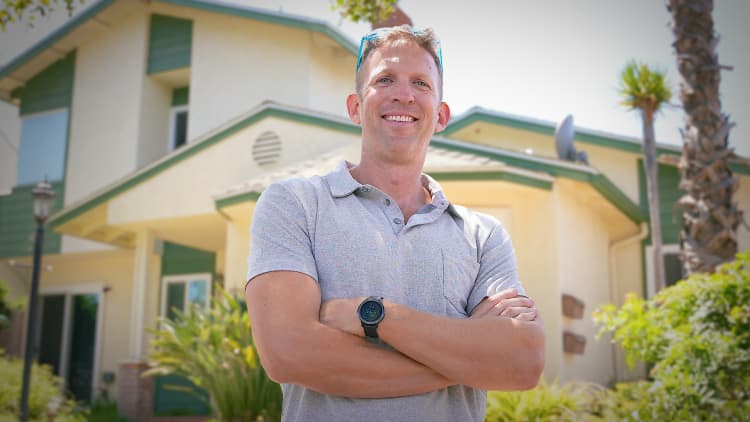
[ad_1]
Courtneyk | E+ | Getty Images
Many Americans are mistaken about their financial preparedness for retirement. But overconfidence skews higher for the wealthy than for others, according to a new report.
Twenty-eight percent of all U.S. households have an overly rosy view: They think they’re on track to maintain their standard of living in retirement but are actually at risk of falling short, according to an analysis by the Center for Retirement Research at Boston College.
The analysis examines these households by income group. Thirty-two percent of high-income households are “not worried enough” about their retirement risk, a larger share than the 26% of low and middle earners.
More from Personal Finance:
‘Quiet luxury’ may be Americans’ most expensive trend ever
3 steps to take before you start investing
Social Security may be key issue for GOP presidential rivals
The divergence between perception and reality can be dangerous, experts said. Such households may be able to save more money during their working years but don’t know they should do so.
“If they’re not aware they should be saving more, they run the risk of having to cut back their consumption — perhaps substantially — in retirement,” said Anqi Chen, senior research economist and assistant director of savings research at the Center for Retirement Research.
They may also be unable to manage some risks in old age like higher health-care costs, added Chen, who co-authored the report.

There’s an important caveat here: The meaning of being “at risk” differs between income groups. Low earners who are at risk may not be able to afford basic living necessities in old age, while an affluent household is unlikely to fall into poverty, for example, the analysis said.
The affluent risk a “difficult adjustment that may require them to lower their expectations of their retirement lifestyle,” the report said.
There are headwinds against retirement security
The analysis leverages data from the U.S. Federal Reserve’s Survey of Consumer Finances, a triennial assessment of households. Its most recent iteration reflects 2019 data.
The Survey of Consumer Finances defines income groups by age and marital status. For example, the 2019 survey defines married couples ages 45 to 47 as low-, middle- and high-income if their median income is $50,000, $110,000 and $248,000, respectively.
The Center for Retirement Research uses the Survey data to construct a National Retirement Risk Index. The index models retirement preparedness according to a range of assets like Social Security, pensions, home equity and employer-sponsored retirement plans, such as a 401(k).
If they’re not aware they should be saving more, they run the risk of having to cut back their consumption — perhaps substantially — in retirement.
Anqi Chen
assistant director of savings research, Center for Retirement Research at Boston College
In 2019, 47% of American households were at risk of not being able to maintain their standard of living in retirement, according to the index. That’s down slightly from the years following the 2008 financial crisis, but up significantly from earlier in the 21st century.
Many factors have put pressure on Americans’ retirement preparedness.
For one, they’re living longer, meaning their savings must stretch over a greater number of years.
Why the rich are more likely to underestimate risk
Westend61 | Westend61 | Getty Images
Nineteen percent of U.S. households correctly identify they’re at risk of falling short in retirement, according to the Center’s report. But the more concerning cohort is the aforementioned 28% of households who aren’t worried enough, experts said.
“The ones who worry me the most are the people who think they’re in good shape but they’re not,” said David Blanchett, head of retirement research at PGIM, the investment management arm of Prudential Financial.
The booming stock and housing markets may be giving a “wealth illusion” to affluent households, who disproportionately own these financial assets, Chen said.
The ones who worry me the most are the people who think they’re in good shape but they’re not.
David Blanchett
head of retirement research at PGIM
For example, the median price of a home sold in the U.S. had jumped to $327,000 by the end of 2019, up from $223,000 at the beginning of 2010, according to federal data tracked by the Federal Reserve Bank of St. Louis. The S&P 500 stock index roughly tripled over that period.
Further, about 24% of affluent households who underestimated their retirement risk had a large amount of housing debt relative to their home equity, three times more than middle and lower earners, according to the Center for Retirement Research analysis.
Social Security also replaces a smaller portion of annual income for wealthy households relative to other income groups — meaning they must save more money to maintain their standard of living.

Saving money is the one thing that “dramatically improves” a household’s retirement readiness, Blanchett said.
Aside from the obvious benefit of having a larger pool of assets from which to draw in old age, saving more money today effectively reduces one’s standard of living, Blanchett said. More money saved means less money spent, and households grow accustomed to living on a lower monthly budget — a lifestyle change that would likely carry into retirement, he added.
The easiest way for households to get a rough sense of their retirement preparedness is by consulting two or three free online retirement calculators and inputting all relevant financial information, Blanchett said. Someone who wants to more detailed examination or personalized plan might consider consulting a financial planner, he said.
[ad_2]
Source link